The Yankees Struck Gold on Aaron Hicks
General Manager Brian Cashman turned a backup catcher into a valuable outfielder who might play a starring role in October.
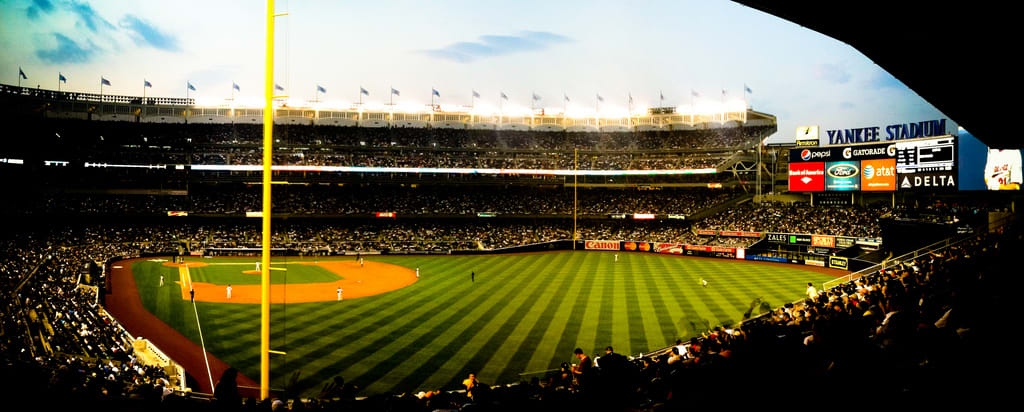
While the top prospects from the Yankees farm system quickly matriculate to the majors, one player acquired in General Manager Brian Cashman’s retool has proven himself worthy of a prominent long-term role on the club. With the arrivals of Aaron Judge and Gary Sanchez to the Bronx, and hot prospects like Gleyber Torres on the way, it’s easy to forget about just how good of a player Aaron Hicks has developed into. Let’s take a brief stroll down memory lane, to Baseball America’s scouting report on Hicks in 2009:
“Sometimes it seems like there's nothing Hicks can't do. He's a premium athlete with growing skills and true five-tool ability. He's a switch-hitter who's a natural from the right side and improved from the left by lowering his hands and unleashing his bat speed. He was more polished and selective at the plate in his debut than the Twins thought he might be, and his eye allowed him to get to his above-average power potential earlier than expected. He projects to hit 20-25 homers annually as he matures. Hicks has plus-plus speed and good baserunning instincts that should improve with experience. He glides to balls in the outfield and has a top-of-the-scale throwing arm that would play in any outfield spot or on the mound if necessary. In the unlikely event he doesn't hit, he can try to make it as a pitcher.”
After his first full season of professional baseball, Baseball America doubled down and ranked him as the 19th best prospect in all of baseball. Of course, things were not smooth for Hicks from there. He scuffled in the minor leagues and didn’t make his debut until 2013. He didn’t catch on in the majors in parts of three seasons, and was traded to the Yankees in the 2015 offseason for a backup catcher. Hicks wasn’t particularly useful in his first year with the Yankees, either, posting a -0.2 Wins Above Replacement (WAR) mark in 361 plate appearances. He bottomed out this spring when he lost the right-field competition to Aaron Judge.
Before you wonder if the Yankees decided to take Baseball America’s advice and turn him into a pitcher, Aaron Hicks confounded his critics. His season has been nothing short of spectacular. Let’s consider the natural strengths that Hicks has always brought to the table. First, his throwing arm:
That’s the fastest throw Statcast has ever tracked from an outfielder. Hicks passes the eye test with flying colors, but let’s consider the numbers as well. Ultimate Zone Rating (UZR) is a defensive metric that (in short) gauges how many theoretical runs above-average a fielder is worth over a period of time. The metric is extremely volatile, so it’s most accurate when used in a large sample size. The given recommendation is three years’ worth of data. Here is the UZR leaderboard for outfielders from 2015 to the present:
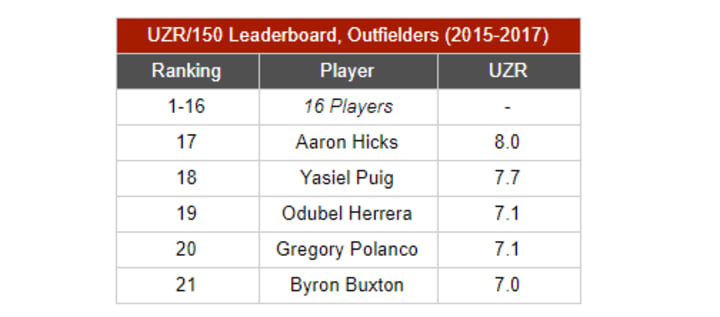
via FanGraphs
Hicks has been one of the 20 or so best defensive outfielders in the game for the past three seasons, so he’s been certainly living up the billing about gliding to balls in the outfield. Another natural athletic tool Hicks has is speed. According to Statcast, the Major League average Sprint Speed is 27 feet per second. Billy Hamilton, the fastest runner in baseball, runs just shy of 30 feet per second. Aaron Hicks runs at 28.1 feet per second, which is, for reference, faster than Jose Altuve. This speed makes him strong on the basepaths and in the outfield. Of course, these natural gifts were always going to be there for Hicks, and without a bat in his hands, he would still be a valuable fourth outfielder. Well, in 2017, the bat has started to come around. Let’s look at Hicks’ natural power, measured in Exit Velocity on fly-balls:
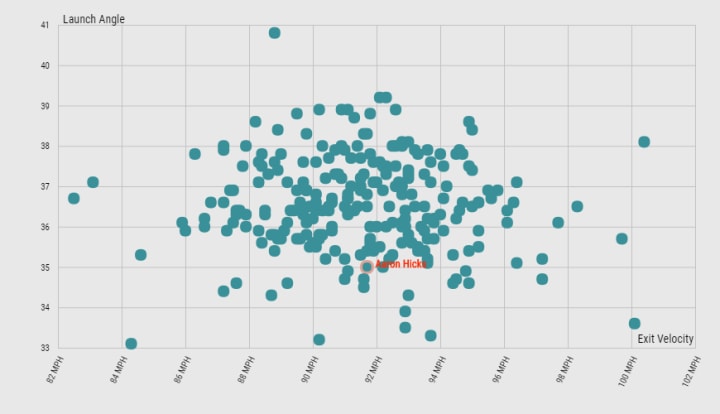
via Baseball Savant
There’s Hicks, in the bottom-right quadrant. That’s exactly where a hitter wants to be, because it means he is hitting the ball both the hardest (according to the X-axis) and at the optimal Launch Angle (according to the Y-axis), which allows him to hit deep, hard drives rather than weak pop-ups. Another fun fact is that his Expected Weighted On-Base Average (xwOBA) on fly balls is .422, which is a higher mark than fly ball connoisseurs Kris Bryant, Justin Turner, and Daniel Murphy.
Yes, Giancarlo Stanton is the dot on the extreme bottom-right. Of course he is.
While power and the ability to use it optimally is a great asset at the plate, having plate discipline is imperative so that one can use those assets consistently. As the old scouting reports say, Hicks is selective at the pitches he swings at, and it’s just as true today as it was in 2009. The statistic Outside-Swing% (O-Swing%, or chase rate) tracks the rate at which a batter swings at pitches outside the strike zone. Hicks has the twelfth-lowest chase rate among Major League outfielders at 22.6 percent. It’s led to an elite walk rate of 13.8 percent, which is the fifth-best rate among Major League outfielders, with only Mike Trout, Aaron Judge, Robbie Grossman, and Bryce Harper ahead of him.
So while all five tools are on display for Hicks this season, we look at the caveat here; he has to be able to maintain plate discipline consistently. Here’s a rolling average of Hicks’ O-Swing% and BB% throughout this season:
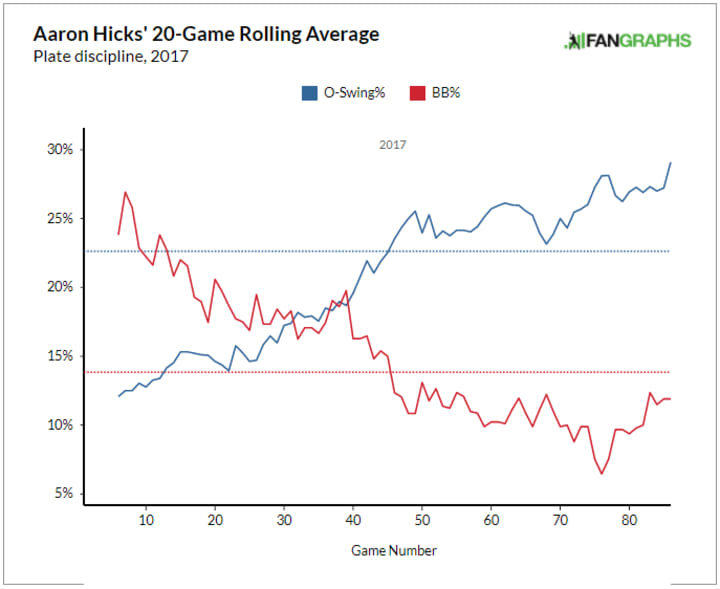
That is not a promising trend for Hicks. When his plate discipline craters, he strikes out easier. When he strikes out easier, he takes less walks and gets less good pitches to hit. When he gets less good pitches to hit, he’s not hitting, as evidenced here:
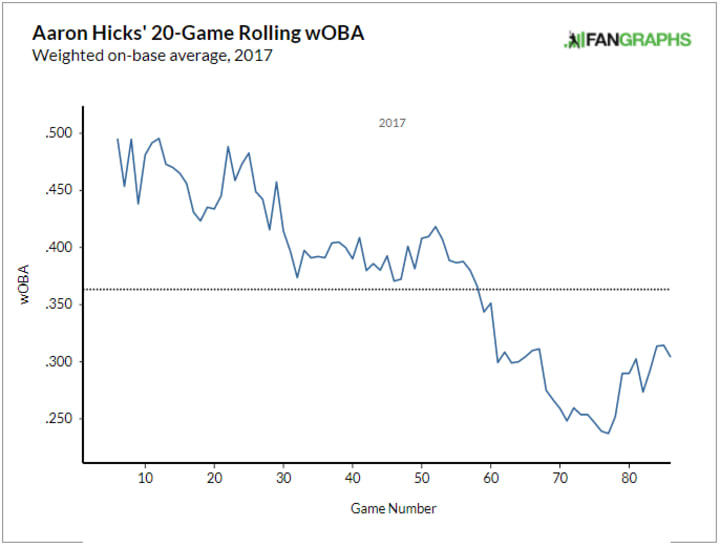
This is Aaron Hicks’ Weighted On Base Average (wOBA), which is a statistic that measures his overall value at the plate. The downward trend is consistent with his decline in walk rate and increase in chase rate in the prior graph.
Now that it’s established that Hick’s success on the plate depends on his plate discipline, we need to consider why he declined from Game 50 to Game 70 after plateauing from Game 30 to Game 50. One would think that his rolling averages from Games 30 through 50 would be his normalized rate because they are consistently close with his season average over a sizable period of time. I want to point you to the big drop Hicks suffered going into Game 60. The dates of those games are 6-25-17 (.351 wOBA), and then 8-10-17 (.299 wOBA). The reason there is such a big gap is that Hicks missed a month and a half with an oblique injury, which was re-injured in September.
Through 354 plate appearances and 86 games in 2017, Aaron Hicks has been a 3-win player for the Yankees. It’s easy to salivate over the thought of Hicks being a 6-win superstar over the course of a full season, but even being a consistent 4-win player would make him extremely valuable, as only ten reached the the 4.5 fWAR mark this season, and only eight actually did so in 2016. Hicks has two arbitration years left, and they’ll be his age 28 and 29 seasons. That’s perfect for the Yankees, who have enjoyed the best outfield production in Major League Baseball by the standards of WAR this season. They should expect more of the same in the next few seasons going forward, and especially this Fall, should the Yankees advance deep into the postseason. Aaron Hicks is another thrifty steal made by GM Brian Cashman. Enjoy this video of Hicks robbing a grand slam last week.
About the Creator
Matt Mocarsky
Matt is an undergrad at the UConn School of Business. He knows that Joey Votto has been in an MLB leading 434 3-0 counts since 2010, and that Carlos Santana is second with only 388. You can follow him on twitter @matthewmocarsky.
Enjoyed the story? Support the Creator.
Subscribe for free to receive all their stories in your feed. You could also pledge your support or give them a one-off tip, letting them know you appreciate their work.



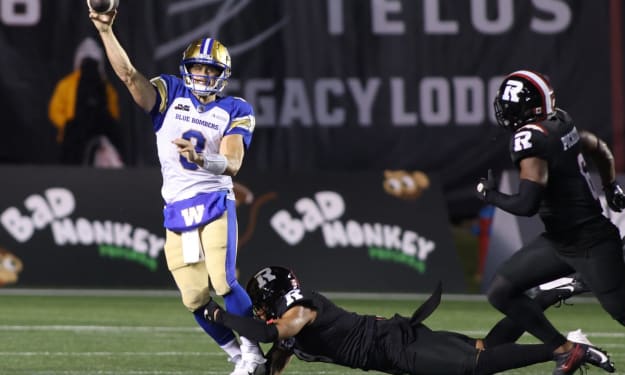


Comments
There are no comments for this story
Be the first to respond and start the conversation.